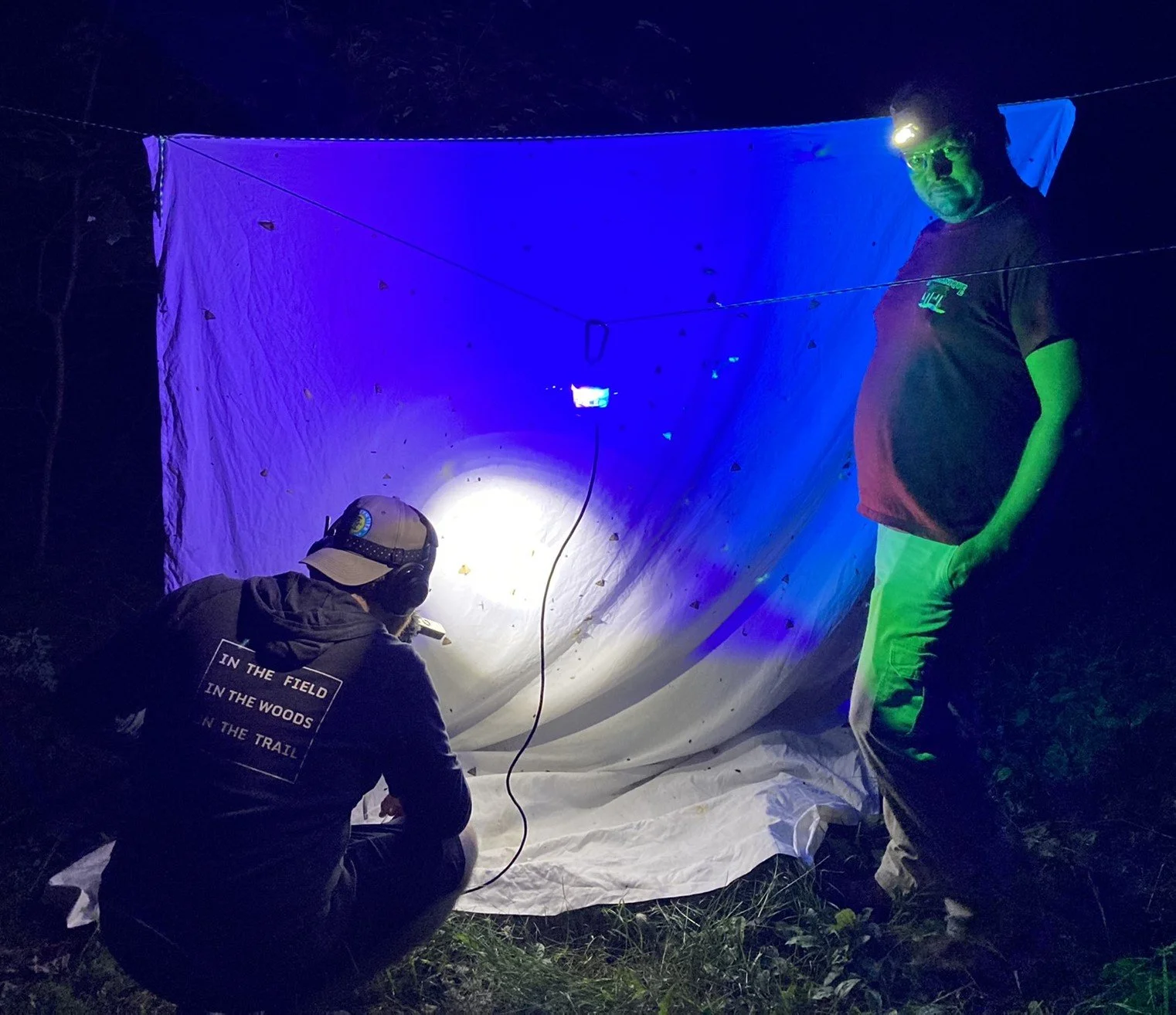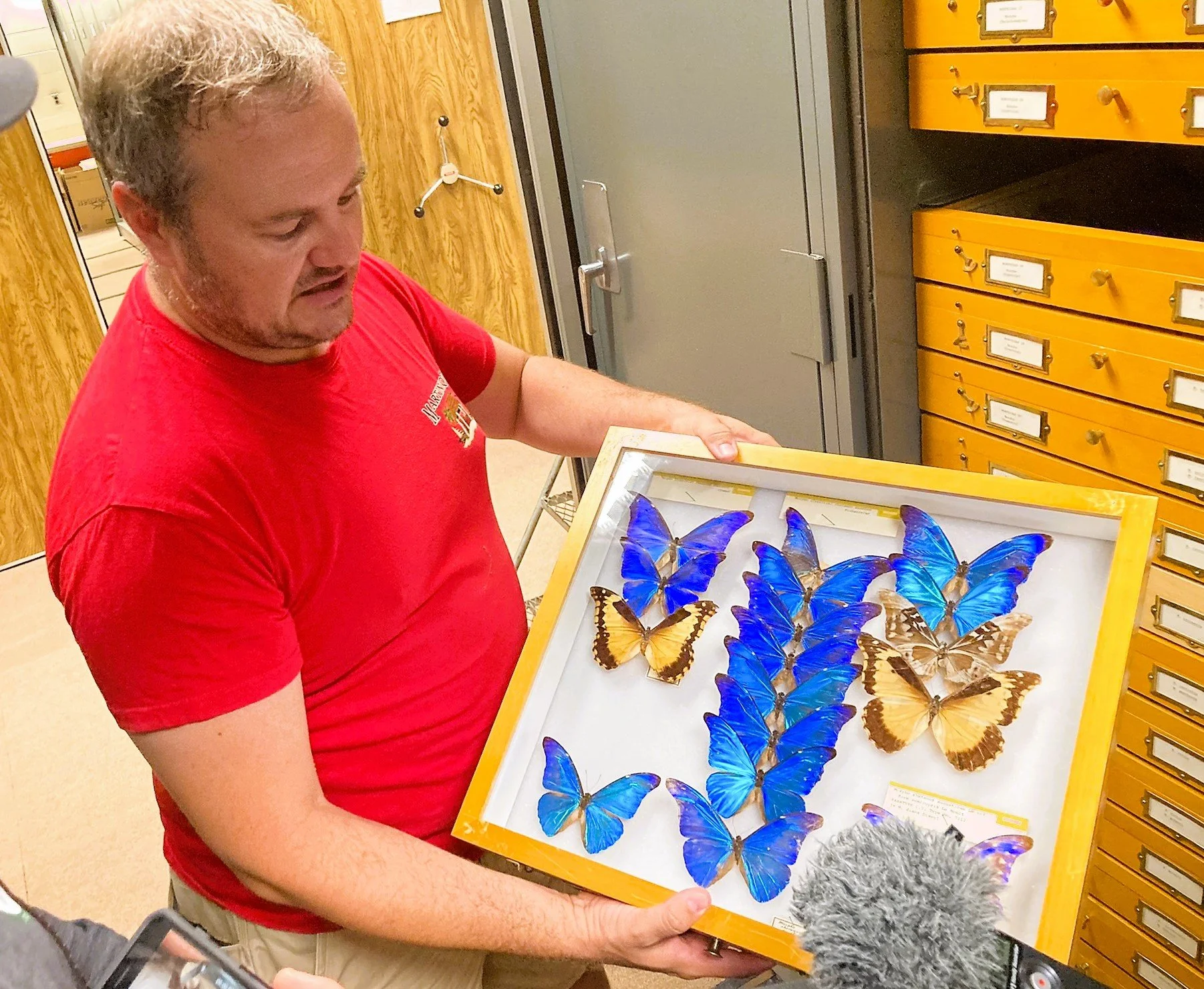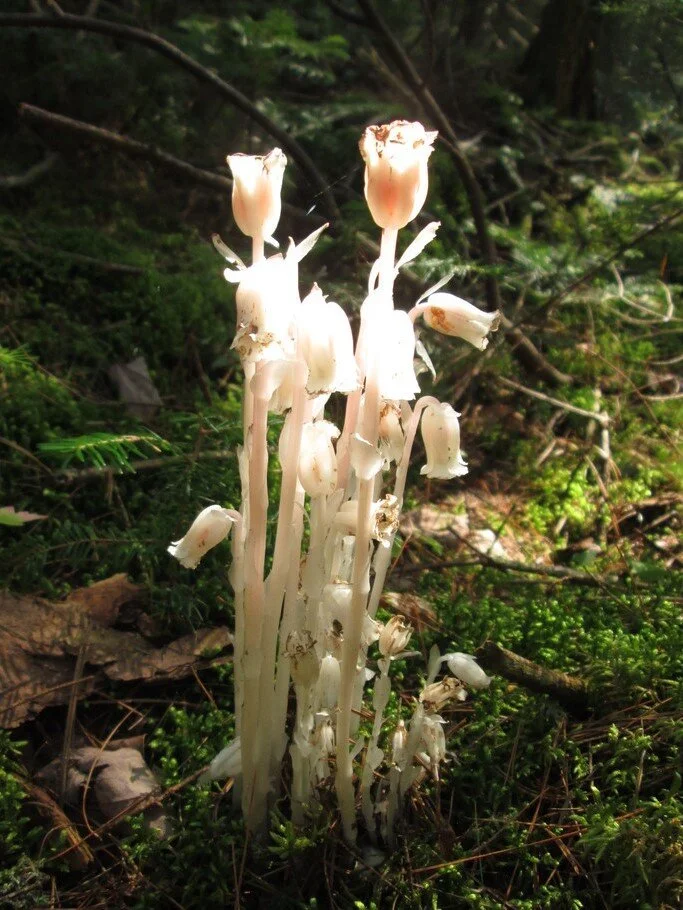Pinesap (Monotropa hypopitys) is a goofy little plant that parasitizes fungi and can often be found beneath pine trees. It is not the sap of pine trees like Daniel thought. In this episode, Bill leads the discussion about the complex relationships between pinesap, its fungal host, and the tree species the fungi has a symbiosis with. Join the guys as they get caught in a sudden rainstorm and learn about this amazing plant.
Ep. 62 - Timber Rattlesnakes: Endangered Danger Noodles(Part 1)
Love ‘em or hate ‘em, we wager you’ll enjoy this dive into the shiny (not slimy) world of rattlesnakes. This episode, the guys take a close look (but not too close) at the Timber Rattlesnake (Crotalus horridus), trying to show how it’s not out to kill you and also finding out how it ended up on the “Don’t Tread On Me” flag. Plus, they introduce the newest field guide, Daniel!
Ep. 58 - Insectapalooza! (Part 2)
Our six-legged celebration continues! In this second part, the guys wrap up their behind-the-scenes tour of the Cornell University Insect Collection with Jason Dombroskie, collection manager and director of the insect diagnostic lab, and THEN, Jason provides the guys with some eye protection and takes them out into the woods for some nighttime mothing!
Ep. 58 - Insectapalooza! (Part 1)
This month, Bill and Steve geek out over insects! And it’s because they were lucky enough to have an even bigger insect geek invite them on a field trip. Jason Dombroskie is the collection manager and director of the insect diagnostic lab at Cornell University. His invite to take the guys mothing in July of 2022 turned into a marvelous, day-long adventure:
In part one, you’ll hear the guys meet up with Jason for a tour of his property and an interview delving into Jason’s background and what it’s like to be a professional entomologist (it involves studying lots of insect genitalia, among other things). We follow that up with a behind-the-scenes tour of the Cornell University Insect Collection - an assemblage spanning over 7 million insect specimens representing about 200,000 species, or roughly 20% of the world’s described insect fauna.
So, strap in and prepare yourself for…Insectapalooza!
Ep. 57 - Mockingbirds Gonna Mock
Have you ever heard a mockingbird imitate a blue jay? How about a seal imitating a Maine fisherman? This month, the guys explore the wild world of vocal mimicry. Birds imitate chainsaws and car alarms, elephants speak Korean; what’s going on? With a special focus on one of the bird world’s best known mimics - the northern mockingbird (Mimus polyglottos) - the guys delve into the research trying to explain why animals - especially birds - feel the need to engage in the wildlife equivalent of, “I know you are, but what am I?”
Ep. 56 - Let's Get Nuts!
Black Walnut (Juglans nigra) is a tree well-known for its ability to negatively affect other plants growing nearby, a phenomenon known as allelopathy. But is Black Walnut really as allelopathic as the Internet would have you believe? In this episode, the guys go nuts: delving into this question and many other facets of the fascinating (and tasty?) Black Walnut, including an on-air tasting of Black Walnut syrup. Enjoy!
Ep. 52 - Who's Your Daddy (Longlegs)?
This month, the guys set out to discover if daddy longlegs really are the most poisonous spider in the world, but, along the way, they uncover a fascinating array of arachnids and adaptations in the group known collectively as harvestmen. Join them for some mythbusting and a deep dive into the little-known order of arachnids called Opiliones.
Ep. 51 - Flickers Foolin' Around: Sex Roles in a North American Woodpecker
The northern flicker (Colaptes auratus) is a common bird that has some exceptionally uncommon behaviors. Unlike most bird species, male flickers take an equal share of egg incubation and feeding, and, in up to five percent of females, a lady flicker will take up with two mates - an older male and a younger male - raising young in two different nests at the same time. In addition, flickers will sometimes lay their eggs in the nests of other flickers, a behavior called intraspecific brood parasitism, another habit rarely seen in birds. Join the guys as they delve into studies exploring the wild and swinging world of northern flicker reproduction.
Ep. 50 - Antifreeze Fleas and More Winter-Active Insects (Feat. Dr. Wayne Gall)
Spring is here! So, what better time to talk about winter-active insects? Steve recorded this one in February with entomologist and all-around-great-guy Dr. Wayne Gall, and there was no way we could wait until next winter to share it! Join Steve and Wayne as they head into the winter woods, peeling back the snowy curtain that conceals the ecology of these fascinating invertebrates.
Ep. 49 - Whither the Snowy Owl? (Part 2)
This winter (2021) marked the first time a Snowy Owl (Bubo scandiacus) was spotted in New York City’s Central Park in 130 years. Why was it there? Where did it come from? Since 99.9% of the population immediately just thinks of Harry Potter when Snowy Owls are mentioned, the guys wanted to cast the proverbial “Lumos!” and shed some light on the subject.
Join them and guest Daniel Mlodozeniec (photographer and naturalist) as they delve into the Snowy Owl’s ecology in part 1. Then, in part 2, come along as they look into the research behind what drives Snowy Owl irruptions, those irregular migrations that cause Snowies to end up in Central Park and even in places like Bermuda and Hawaii!
Ep. 49 - Whither the Snowy Owl? (Part 1)
This winter (2021) marked the first time a Snowy Owl (Bubo scandiacus) was spotted in New York City’s Central Park in 130 years. Why was it there? Where did it come from? Since 99.9% of the population immediately just thinks of Harry Potter when Snowy Owls are mentioned, the guys wanted to cast the proverbial “Lumos!” and shed some light on the subject.
Join them and guest Daniel Mlodozeniec (photographer and naturalist) as they delve into the Snowy Owl’s ecology in part 1. Then, in part 2, come along as they look into the research behind what drives Snowy Owl irruptions, those irregular migrations that cause Snowies to end up in Central Park and even in places like Bermuda and Hawaii!
Ep. 48 - Eat Sh*t and Live, Bill (Part 2)
Now that Bill’s done droning on about animals, we can finally talk about PLANTS! and CARNIVOROUS plants at that. Steve reviews carnivorous plants in general and then breaks into examples of carnivorous plants that have evolved to eat poop: Roridula spp. in South Africa, Sarracenia purpurea in North America, & Nepenthes spp. in Southeast Asia.
Ep. 48 - Eat Sh*t and Live, Bill (Part 1)
With the high-end guests we’ve recently had on, we’re concerned that the podcast is getting a bit too classy. So, this month, we’re getting down and dirty, delving into the delightful topic of defecation. Specifically, animals and plants that eat poop. We know, it seems gross. We thought so, too. But once we started exploring this surprisingly common behavior (called coprophagy), we were amazed at what we uncovered!
Ep. 47 - Field Trip!: Exploring the Roger Tory Peterson Institute (Part 2)
Welcome to part 2 of our field trip to the Roger Tory Peterson Institute. In this segment, Bill and Steve take a hike with Twan Leenders, Senior Director of Science & Conservation at the Institute. Twan has had a career in conservation that deserves to be made into a movie. From researching wildlife in the treetops of Central American rainforests to corralling ornery spiny softshell turtles in post-industrial rivers, Twan’s stories, as well as his personal philosophy on science communication, make for a fascinating listen. Enjoy!
Ep. 47 - Field Trip!: Exploring the Roger Tory Peterson Institute (Part 1)
This month, Bill and Steve visit The Roger Tory Peterson Institute in Jamestown, NY. In part 1, we talk with CEO Arthur Pearson, delving into Roger Tory Peterson’s background, his influence on the modern field guide, how field guides influence conservation, and how the Institute seeks to bridge people’s passions for art, nature, and conservation.
Ep. 45 - In Search of A Nice Set of Pipes
Rising from the forest floor in a ghostly array of pale, slender stalks, Ghost Pipe (Monotropa uniflora), AKA Indian Pipe, is a forest floor denizen both beautiful and extraordinary. Many people mistake it for a fungus because It lacks chlorophyll. For many years, botanists argued over how it gathered nutrients. It's range stretches almost continent-wide, but its not always easy to find. In this episode, the guys hit the trail and delve into the backstory of this elusive and mysterious beauty.
Bonus 09 - Finding a Job in the Wild - An Interview with Matt Gaffney
Have you ever dreamed of ditching your day job and pursuing a career in the woods? Maybe working with wolves in the desert southwest or conducting plant surveys in the wilds of Alaska? Well, Matt Gaffney did it! Leaving behind a job in digital marketing, he went back to school to get his degree in environmental studies and went on to work a series of seasonal positions with the National Forest Service. Bill caught up with him in August of 2019 in the Monongahela National Forest in West Virginia. Join them on a hike on Spruce Knob (the highest point in WV) as Matt shares his adventures and advice on pursuing a career in the wild!





















